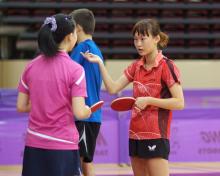Developing a basic Tactical Plan for competitions
Every player devotes most of his/her time to technical training; but tactical training is essential to apply the technique in every match and competition. Tactical training’s objective is that the player learns how to carry out a plan during the game; and this varies from one player to another. So, this plan must be properly structured.
Here I give you a list of very basic factors, for the athlete and the coach, which we should be aware of, and know how to apply.
1. Our strengths: Player and coach must know the technical elements, strokes, and trained situations or scenarios, which are executed and applied with better quality and regularity.
2. Our weaknesses: Player and coach must know the technical elements, strokes, and actions, where our performance is lower; where we make the most mistakes.
3. Opponent’s strengths: The technical elements, strokes, combinations, and actions, which are executed by my opponent with a better quality and regularity.
4. Opponent’s weaknesses: The technical elements, strokes, actions and combinations, where the rival has his/her worst performance, where he/she makes the most mistakes.
Therefore, the goals are:
- To be able to develop and execute, during the match, our strongest elements, in as many points as we can. Always, having the possibility of including variants at the required moments. Basically, not allowing and preventing the opponents from accomplish theirs.
- To implement this plan with tactical discipline. To make the opponents execute their weakest strokes, and movements. To take the game wherever it is more convenient for us.
- Trying not to fall into a game, where we have to use our weakest areas is important. It is like playing chess, where we have to optimize our strengths and discover our opponent’s weaknesses.
This includes:
Studying the opponents. Observing, if the players’ game is eminently offensive, defensive or mixed; if he/she looks to win a point quickly, or through the control; if their most powerful strokes are the ones with or without spin; if they hit the ball near the table, or away from it; if their best attacks are crossed or parallel; if they move well, or fast; if their lateral and diagonal travels are good. Also, it is essential to study and read their services. To observe the quality and variety of our opponent services, will give us elements that allow us to do proper planning. Every player has some struggle. If we are prepared, by training carefully for each of them, we can successfully overcome these matches; even against players, apparently, stronger than us.
Francisco Mendez, 9 times Mexican Champion
USATT Level 5 and ITTF Level 1 Coach
Basic Plans

Written By Francisco Mendez
Category:



